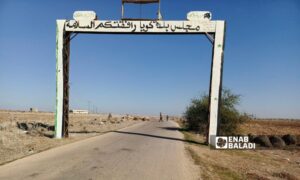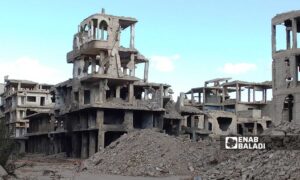
Republishing ‘Caesar’ torture photos online triggers debate among Syrians

Enab Baladi – Taim al-Hajj
Once the United States imposed sanctions against the government of the Syrian regime on 17 June under the Caesar Syria Civilian Protection Act (a.k.a. Caesar Act), Syrian users have flooded social media sites with welcoming posts by the American step, assuming that these sanctions on the grounds will establish the first stage in the journey of holding the Syrian regime and its pillar accountable for human right abuses.
Caesar’s act supporters showed different reactions to the publication of thousands of images of tortured detainees that the Syrian military defector, using the pseudonym Caesar, leaked extensively on social media. They split into two separate groups.
The first group calls for stopping the publication of the torture images to respect the feelings of the families of the victims. The other group insists on circulating the torture images on social media sites, including Facebook, Twitter, and even WhatsApp, arguing that the world needs to see the ugly truth of the Syrian regime and its atrocities, in addition to that, people need to know the fates of their missing loved ones, maybe ‘Caesar’ took pictures of them.
Between supporters and opponents
In an opinion poll conducted by Enab Baladi on its Facebook page, 75 of the participants, who numbered about 1,700 users, voted for the publication of “Caesar” torture images on social media sites without the permission of the victims’ families, saying that it is a way to expose the flagrant violations committed by the Syrian regime against the Syrian people. Besides, these images help identify the unknown fate of people who were detained or forcibly disappeared for years.
On the other hand, 25 percent of respondents believe that posting the photos on social media networks increases the sufferings of detainees’ families and friends, especially as the pictures show the signs of brutal torturing and maiming of the victims.
Ismail al-Hani, who is the father of one of the detainees, tends to the viewers’ view of publishing the photos and says he has known his detained son since 2011.
Ismail al-Hani, a father of a detainee, has a common view with the supporters of the release of the Caesar photos, adding that he confirmed the death of his son, who had been detained since 2011 through photos shared on social media sites.
Al-Hani, in an interview with Turkey’s state-run Anadolu Agency, said that he was shocked to see his son killed under torture, adding that his son Muhammad was 40 years old when he got arrested at a checkpoint placed by the Syrian regime forces between the city of Maraat al-Numan and the village of Maar Shurin in the southern countryside of Idlib in 2011.
Al-Handi said that “We recently heard that there was a law codenamed Caesar, so people came to me in the village I was displaced to, showing me the pictures that were published for the detainees killed under torture and found my son Muhammad among them.”
On the other hand, activists talked about the death of a Syrian father who had a heart attack after seeing his son’s corpse among the pictures of victims died under torture in the prisons of the Syrian regime.
This incident reinforces why some people refuse the release of “Caesar” torture photos, saying that they are too painful.
“Caesar” and the date of the torture photos
The name “Caesar” belongs to the Syrian officer, who defected from the Syrian regime and smuggled 55,000 photos to 11,000 detainees killed under torture in 2014.
The US Federal Bureau of Investigation (FBI) confirmed the authenticity of the Caesar photographs, which aroused worldwide public opinion at that time, and they were displayed in the US Senate.
The photos that spread during June 2020 on social media sites are not all new, because part of them was published in 2014.
After the Caesar Act came into effect, the other part of photos was released, which was met with wide-interaction across the country. This was evident in the touching posts shared by the families of the victims. The families expressed shock and outrage when they recognized the corpses of their loved ones who were cruelly tortured to death in the prison of the Syrian regime.
Between concepts of moral and morality
Fadel Abdul Ghany, the chairman of the Syrian Network for Human Rights (SNHR), which documents the violations that are taking place in Syria, believes that the release of “Caesar” torture photos is a “complex and sensitive issue,” stressing that he is against the random and aimless release of pictures, but simultaneously, he does not support a total ban on the photos.
Abdul Ghany told Enab Baladi that no one has the authority to prevent the dissemination of “Caesar’s” images, explaining that the dissemination should be part of a strategy and mechanisms that the detainees’ families should be informed about.
Abdul Ghany justified his refusal to publish the photos in a disorderly manner, arguing that many families of the victims knew about the fate of their loved ones a long time age, and by re-posting the photos, those families are negatively affected.
From the viewpoint of Abdul Ghany, the families are the ones who have the right to publish the photos of their relatives, referring to the need to inform those who search in the pictures of “Caesar” that they document the period between September 2011 and August 2013.
Regarding the republication of photographs, Abdul Ghany said that this came as a response to the supporters of the Syrian regime and its media outlets, which are promoting that the Caesar Act is the reason behind the deterioration of the economy in the areas controlled by the Syrian government. He considered that the use of photos for this purpose is “inappropriate,” stressing that only the families of the victims have the right to use the images for particular goals.
“Respect for the victims’ families”
“Caesar’s Files Group” (CFSG) issued a statement addressed to the families of the victims, in which it denied its responsibility for republishing the pictures, saying, “We have nothing to do with the publication and circulation of images from other accounts on websites and newspapers.”
“CFSG” also held everyone who publishes these pictures without their permission” fully legal responsibility.
The statement pointed out that the “CFSG” works to communicate with the families directly without publishing the victims’ photos in public, in order to respect the privacy of the victims, their families, and their feelings, stressing that any of the detainees’ families can contact them through the official website of the group.
Marwan al-Ash, Secretary of the Syrian Committee for Detainees and human rights activist, told Enab Baladi that it is necessary to reveal the fate of every person detained, forcibly disappeared or kidnapped, and that dealing with the entire file of detainees is a “legal and international contract.”
Al-Ash believes that there is an ethical, legal, and social duty to publish “Caesar’s” pictures, which lies in stopping the blackmailing of the families.
He supports publishing the photos in a manner that takes into account the feelings of the detainees’ families and avoids their shock from seeing their loved ones in the cruel way shown in the pictures, noting the need to publish them on specific sites within certain criteria, and only for “people wishing to see.”
if you think the article contain wrong information or you have additional details Send Correction
النسخة العربية من المقال
-
Follow us :

















 A
A
A
A
A
A








 More Politics
More Politics